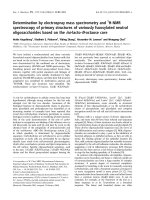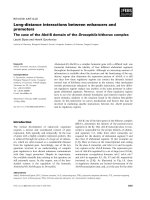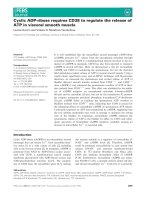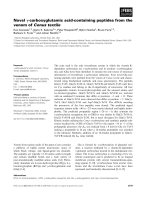báo cáo khoa học: "Gastrointestinal Stromal Tumours treated before and after the advent of c-kit immunostaining" pptx
Bạn đang xem bản rút gọn của tài liệu. Xem và tải ngay bản đầy đủ của tài liệu tại đây (217.04 KB, 4 trang )
RESEARCH Open Access
Gastrointestinal Stromal Tumours treated before
and after the advent of c-kit immunostaining
Paolo G Sorelli
1*
, Patrizia Cohen
2
, Bafour Amo-Takyi
2
, Nikitas A Theodorou
1
and Peter M Dawson
1
Abstract
Background: Recently developed immunohistochemical markers have revolutionised the classification of
gastrointestinal stromal tumours (GISTs) whilst tyrosine kinase inhibitors (imatinib) have had a significant impact on
the treatment of advanced tumours. We review the clinicopathological features of previously resected
mesenchymal tumours of the gastrointestinal tract in our institution to 1) reclassify the histological diagnosis of
those stained prior to c-kit availability; 2) perform survival analysis to identify prognostic factors, and 3) to consider
the implications for patients.
Methods: Clinicopathological records of patients with a diagnosis of mesenchy mal tumours treated between May
1992 and April 2007 were reviewed.
Results: 82 patients were reviewed. 26 (32%) were reclassified as GISTs following c-kit immunostaining and a
further 14 patients were treated for GIST up to April 2007 (Total: 40 patients; 21 males and 19 females, mean age
67, range 30-92 years). 36 (90%) underwent complete resection. 5-year sur vival of patients with GIST alone was
80%. Females had a better median survival (M: F 43 months: 73 month s).
Conclusions: The availability of c-kit staining allowed 32% of previously diagnosed mesenchymal tumours to be
reclassified as GISTs. This may have implications for the follow-up of patients diagnosed prior to the availability of
this me thod.
Introduction
Gastrointestinal stromal tumours (GISTs) are the most
common form of mesenchymal (connective tissue)
tumours of the GI tract. They are rare and represent
approximately 0.3-3% of all gastrointestinal tumours [1].
In the last decade studies have discovered that nearly all
GISTs are characterised by the expression of the c-kit
receptor (CD117), as is their cell of origin, the intersti-
tial cell of Cajal [2]. Detection of the c-kit protein in
tumour cells by immunohi stochemistry is now the stan-
dard criterion for the diagnosis of GIST. The most
recent estimated incidence of GIST ranges between 1.1-
1.46/100 000 per year based on national epidemiological
studies [3-5].
Surgery is the standard of care for primary disease.
However 40%-90% of surgically resected tumours recur
[6]. Overall survival after surgical resection and clinical
behaviour of GIST are dependent on tumour size and
mitotic count [7,8]. All tumours have the potential to
become malignant and Fletcher et a l [9] proposed a
scheme for defining the risk of aggressive behaviour of
GIST into different classes, based on tumour size and
mitotic count [10,11].
GISTs can occur anywhere in the GI tract, however
most GISTs arise in the stomach or small intestine and
infrequently in the colon or rectum, oesophagus, mesen-
tery, or omentum, [12,13]. Patients may present with
few or no symptoms depending on the size and location
of the tumour mass. Small GISTs (2 cm or less) are
usually asymptomatic and found incidentally during
investigations or surgical proc edures for unrelated
causes. Larger GISTs can present with GI bleeding, a
palpable mass, obstruction or abdominal pain.
The aim of our study was to review the clinicopatho-
logical features of previously resected mesenchymal
tumours of the GI tract in our institution in order to 1)
reclassify the histological diagnosis of those stained
prior to c-kit availability, 2) perform survival a nalysis to
* Correspondence:
1
Department of GI Surgery, Imperial College NHS Trust, Charing Cross
Hospital, Fulham Palace Road, London, W6 8RF, UK
Full list of author information is available at the end of the article
Sorelli et al. World Journal of Surgical Oncology 2011, 9:44
/>WORLD JOURNAL OF
SURGICAL ONCOLOGY
© 2011 Sorelli et al; licensee BioMed Central Ltd. This is an Open Access article distributed under the terms of the Creative Commons
Attribution License ( .0), which permits unrestricted use, distribution, and reproduction in
any medium, provided the original work is properly cited.
identify prognostic factors, and 3) consider the implica-
tions of informing patients of their new diagnosis.
Materials & methods
A retrospective review of casenotes of patients treated
for mesenchymal tumours of the GI tract between Ma y
1992 and April 2007 was performed. The patients’ age,
gender, tumour site and size after resection, date of sur-
gery, extent of surgical resection, risk group according
to the classification proposed by Fletcher et al, the pre-
sence and date of local recurrence or distant metastasis,
and the clinical outcome until last follow-up, including
date of death where appropriate, were recorded. Statisti-
cal analysis was performed using SPSS 12.0 software
(Chicago, IL, USA). Overall actuarial survival was calcu-
lated from the day of surgery until death or the last day
of a patient’s visit to the outpatient clinic. Survival
curves were plotted using Life Tables, and multivariate
analysis performed using Cox regression analysis.
Curves were compared using Lee-Desu statistics or Chi-
Square.
Histopathological re-examination of surgical speci-
mens was carried out by 2 Consultant Histopathologists
(PC/BA) using standard hematoxylin and eosin staining
as well as specific immunohistochemical techniques
allowing the identification of tumour’ssizeandnumber
of mitosis at high-power field (HPF). Mutational analysis
for c-KIT/PDGFRA tyrosine kinase r eceptor genes was
not performed.
Results
82 specimens previously classified as mesenchymal
tumours of the GI tract between May 1992 and July
2003 were reviewed histologically of which 26 (32%)
were reclassified as GIST follow ing c-kit immunostai n-
ing. A further 14 patients were treated for GIST up to
April 2007 following routine c-kit staining, introduced
in our institution in 2003. A total of 40 patient case-
notes were reviewed (21 males and 19 females, mean
age 67, range 30-92 years). There was no significant dif-
ference in measured parameters between the patients
identified retrospectively prior to routine c-kit immu-
nostaining, and those identified aft er its routine adop-
tion. At time of study 18 (45%) patients had died, 12
(30%) were lost to follow up.
Tumours were l ocated in the stomach, small bowel,
large bowel and retrope ritoneum in 24 , 7, 5 and 4 cases
respectively. Using the “risk of aggressive behavior” clas-
sification proposed by Fletcher et al tumours were clas-
sified as very low (6/40), low (9/40), intermediate (6/40)
and high-risk (19/40). Four patients had separate pri-
mary malignancies at presentation (rectal 1, stomach 2,
sigmoid 1) with the GIST tumour resected as an inci-
dental finding. 3 patients went on to develop separate
primary tumours following complete resection of GIST
(colorectal 1, ovary 1, bladder 1).
Thirty-six patients (90%) underwent complete resec-
tion. Three (7.5%) had incomplete resection due to
degree of local invasion, all of which w ere high risk
GISTs. 1 patient had unresectable disease and under-
went chemotherapy. The 5 year overall survival was 42%
with a median survival of 46 months. The 5 year survi-
val of pa tients with GIST alone irrespective of complete
resection was 80%. The presence of separate malignancy
significantly decreased 5 year survival from 50% to 13%
(median survival from 100 months to 32 months) which
reached statistical significance (p = 0.041) (Figure 1).
Complete resection of GIST in these patients did not
affect 5 year survival. Median survival after complete
and incomplete resection for patients with GIST alone
was 74 months versus 11 months respectively. High-risk
tumours had a shorter survival than low and very low
risk tumours (93 months versus 43 months). There was
no statistically sign ificant difference in survival by the
location of tumour. Females had a better median survi-
val than males both overall (median survival 73 months
versus 43 months) and in the patients without separate
malignancy ( median surviva l 73 months ve rsus 37
months). Multivariate analysis identified complete resec-
tion and sex as the most important positive prognostic
factors, and the presence of separate mali gnancy as the
most important negative prognostic factor for survival.
Of the 26 patients who were reclassified as having
GISTs, 16 have died and 10 were lost to follow up.
Discussion
Inthisstudywehavedemonstratedthatathirdof
patients previously diagnosed with mesenchymal
tumours of the gastrointestinal tract treated before the
advent of c-kit immunostaining were r eclassified as
120100806040200
fu
p
1.0
0.8
0.6
0.4
0.2
0.0
C
um
S
urvival
no
yes
OtherMalignanc
y
Survival Function
Figure 1 Life Table showing survival by separate malignancy.
Sorelli et al. World Journal of Surgical Oncology 2011, 9:44
/>Page 2 of 4
GISTs following positive immunohistochemical staining
with c-kit.
Radical surgery to achieve complete resection remains
the treatment of choice. The aim of treatment for
GISTs identified with c-kit immunostaining, and
tumours treated pre c-kit staining as mesenchymal
tumours of the GI tract, rem ains complete resection.
Therefore in our study management of the patients trea-
ted for GIST pre a nd post c-kit staining was the same.
Previous studies have reported 5 year survival following
complete resection between 35-75% [8,10,14-16]. Our
findings suggest even higher 5 year survival rates can be
achieved. Treatment may be improved by neoadjuvant
or adjuvant imatinib therapy although its potential role
for large or incompletely resected tumours is yet to be
confi rmed [17,18]. Imatinib has been shown to be effec-
tive in locally advanced and irresectable or metastatic
GISTs [19,20] and its use is now recommended in these
patients [21]. No patients in our study were eligible for
imatinib therapy.
We found no significant correlation between site of
GIST and survival. Miettinen et al [22] have suggested
thatgastricGISTshaveamorefavourableprognosis
than intestinal ones with similar histological parameters.
They proposed a different classification of GISTs into 8
subgroups in relation to size and mitotic rate in o rder
to better define the rate of metastases in GISTs at dif-
ferent sites. Surviva l analysis in our populat ion of GISTs
according to Miettinen’s classification are summarised
in Table 1. In the less aggressive histological groups gas-
tric GISTs had an overall improved median survival
when compared to small bowel GISTs, however t he
improved survival was reversed in the more aggressive
histological groups. More recently Tryggvason et al con-
firmed with their series that nongastric GISTs had a
clearly higher risk of malignant behaviour than gastric
GISTs [4].
We demonstrated a survival benefit in females in both
univariate and multivariate analysis. Keun Park et al [23]
have also recently found a survival advantage in females
but only in univariate analysis. Comparison of the two
groups in our study did not reveal any obvious con-
founding factors, however further analysis with larger
numbers are required to reveal any statistical signifi-
cance to this finding.
The optimal follow-up protocol for resected GISTs
has not been firmly established. Recurrence appears to
be possible even after many years and may be of slow
onset. GISTs are resistant to conventional chemotherapy
with a poor response rate (7-20%), and short response
duration (1-4 months) [24]. Imatinib is effective therapy
for patients with advanced metastatic or unresectable
GIST and its use has significantly changed the manage-
ment and prognosis for these patients [20,21]. Keun
Park et al [23] showed that adjuvant imatinib for pri-
mary resected intermediate and high-risk GISTs signifi-
cantly improved recurren ce-free survival, and more
recently DeMatteo et al [25] confirmed, following a ran-
domised, double-blind, placebo-controlled trial, that
imatinib improves recurrence-free survival following
complete resection of GISTs.
Some clear recommendations of management of such
retrospectively identified cases would be of value. The
question arises as to whether patients previously diag-
nosed with mesenchymal tumours should now have
their diagnosis reviewed with the aim of identifying
patients who may be at risk of recurrence and therefore
may benefit from follow up with a view to earlier diag-
nosis and further treatment. Given the time for which c-
kit has now been available and in regular use it is likely
that such patients have either succumbed to recurrence
of the disease or are free and cured with little affect on
their pro gnosis. However this data would be important
to further elucidate this as well as the natural history
and progression of such tumours, and the impact that
c-kit has had on overall prognosis of patients suffering
from GIST.
Conclusions
The wide spectrum of histological terms that have been
used in the past to identify GIST has made definition of
its real incidence and survival difficult. Our study shows
that approximately 1/3 of previously diagnosed
mesenchymal tumours of the gastrointestinal tract could
now be reclassified as GISTs. We confirm that the
groups of risk of aggressive behaviour defined by
Fletcher et al are significantly related to prognosis, with
the low and very low risk category having improved
median survival compar ed to the high risk group. Com-
plete resection remains the most important prognostic
factor and we have demonstrated that an 80% 5 year
Table 1 Median survival in GISTs of stomach and small
intestine by tumours grouped by mitotic rate and
tumour size as proposed by Miettinen et al
21
(n = 40)
Tumour parameters Median survival (months)
Group Size Mitotic rate Gastric Small bowel Other
1 ≤2cm ≤5 per 50 HPFs
2>2≤5cm ≤5 per 50 HPFs
3a >5≤10 cm ≤5 per 50 HPFs
3b >10 cm ≤5 per 50 HPFs
4 ≤2 cm >5 per 50 HPFs
5>2≤5 cm >5 per 50 HPFs
6a >5≤10 cm >5 per 50 HPFs
6b >10 cm >5 per 50 HPFs
Sorelli et al. World Journal of Surgical Oncology 2011, 9:44
/>Page 3 of 4
survival can be achieved in our cohort of patients. The
advent of new therapies may have implications for
further possible treatment in patients with advanced or
recurrent disease. This therefore raises the question as
to whether the diagnosis of all previously undefined
mesenchymal t umours of t he GI tract where c-kit
immunostaining was not performed should be revised
and patients with confirmed GISTs contacted with a
view to further follow up.
Author details
1
Department of GI Surgery, Imperial College NHS Trust, Charing Cross
Hospital, Fulham Palace Road, London, W6 8RF, UK.
2
Department of
Histopathology, Imperial College NHS Trust, Charing Cross Hospital, Fulham
Palace Road, London, W6 8RF, UK.
Authors’ contributions
PS, NT and PD guarantee the integrity of the entire study. PS, PC, NT and PD
developed the study concepts and design. PS undertook the literature
research. BA and PC performed the histological studies. PS and PD
performed the data and statistical analysis. PS prepared the manuscript. All
authors read and approved the final manuscript.
Competing interests
The authors declare that they have no competing interests.
Received: 11 August 2010 Accepted: 27 April 2011
Published: 27 April 2011
References
1. Rossi CR, Mocellin S, Mancarelli R, Foletto M, Pilati P, Nitti D, Lise M:
Gastrointestinal stromal tumours: from a surgical to a molecular
approach. Int J Cancer 2003, 107:171-176.
2. Kindblom LG, Remotti HE, Aldenborg F, Meis-Kindblom JM: Gastrointestinal
pacemaker cell tumour (GIPACT): gastrointestinal stromal tumours show
phenotypic characteristics of the interstitial cell of Cajal. Am J Path 1998,
152(5):1259-1269.
3. Rubió J, Marcos-Gragera R, Ortiz MR, Miro j, Vilardell L, Girones J,
Hernandez-Yague X, Codina-Cazador A, Bernado L, Izquierdo A, Colomer R:
Population-based incidence and survival of gastrointestinal stromal
tumours (GIST) in Girona. Spain. Eur J Cancer 2007, 43:144-148.
4. Tryggvason G, Gíslason HG, Magnússon MK, Jónasson JG: Gastrointestinal
stromal tumors in Iceland, 1990-2003: the icelandic GIST study, a
population-based incidence and pathologic risk stratification study. Int J
Cancer 2005, 117(2):289-93.
5. Mucciarini C, Rossi G, Bertolini F, Valli R, Cirilli C, Rashid I, Marcheselli L,
Luppi G, Federico M: Incidence and clinicopathologic features of
gastrointestinal stromal tumors. A population-based study. BMC Cancer
2007, 7:230.
6. Pidhorecky I, Cheney RT, Kraybill WG, Gibbs JF: Gastrointestinal stromal
tumours: current diagnosis, biologic behaviour, and management. Ann
Surg Onc 2000, 7(9):705-712.
7. Boni L, Benevento A, Dionigi G, Rovera F, Dionigi R: Surgical resection for
gastrointestinal stromal tumours (GIST): experience on 25 patients. World
J Surg Oncol 2005, 3:78.
8. Miettinen M, El-Rifai W, Sobin LH, Lasota J: Evaluation of malignancy and
prognosis of gastrointestinal stromal tumours: a review. Hum Path 2002,
33:459-465.
9. Fletcher C, Berman J, Corless C, Gorstein F, Lasota J, Longley BJ,
Miettinen M, O’Leary TJ, Remotti H, Rubin BP, Shmookler B, Sobin LH,
Weiss SW: Diagnosis of gastrointestinal stromal tumours: a consensus
approach. Hum Pathol 2002, 33:478-483.
10. DeMatteo R, Lewis JJ, Leung D, et al: Two hundred gastrointestinal
stromal tumours: recurrence patterns and prognostic factors for survival.
Ann Surg 2000, 231:51-64.
11. Bilimoria M, Holtz DJ, Mirza NQ, Feig BW, Pisters PW, Patel S, Pollock RE,
Benjamin RS, Papadopoulos NE, Plager C, Murphy A, Griffin JR, Burgess MA,
Hunt KK: Tumour volume as a prognostic factor for sarcomatosis. Cancer
2002, 94:2441-2446.
12. Chan JKC: Mesenchymal tumours of the gastrointestinal tract: a paradise
for acronyms (GUMP, GIST, GANT, and now GIPACT). Implications of c-kit
in genesis, and yet another of many emerging roles of the interstitial
cell of Cajal in the pathogenesis of gastrointestinal disease. Adv Anat
Pathol 1999, 6:19-40.
13. Miettinen M, Sarlomo-Rikala M, Lasota J: Gastrointestinal stromal tumours.
Ann Chir Gynaecol
1998, 87:278-281.
14. Chiappa A, Zbar AP, Innis M, Garriques S, Bertani E, Biffi R, Pruneri G,
Luzzato F, Vigna PD, Trovato C, Andreoni B: Prognostic factors affecting
survival after surgical resection of gastrointestinal stromal tumours: a
two-unit experience over 10 years. World J Surg Oncol 2006, 4:73.
15. Trupiano JK, Stewart RE, Misick C, Appelman HD, Goldblum JR: Gastric
stromal tumours: a clinicopathologic study of 77 cases with correlation
of features with nonaggressive and aggressive clinical behaviors. Am J
Surg Pathol 2002, 26(6):705-14.
16. Nikfarjam M, Kimchi E, Shereef S, Gusani NJ, Jiang Y, Liang J, Sehmbey M,
Staveley-O’Carroll KF: Surgical Outcomes of Patients with Gastrointestinal
Stromal Tumours in the Era of Targeted Drug Therapy. J Gastrointest Surg
2008, 12(11):2023-2031.
17. DeMatteo RP, Heinrich MC, El-Rifai WM, Demetri G: Clinical management
of gastrointestinal stromal tumours: before and after STI-157. Hum Pathol
2002, 33:466-477.
18. Joensuu H, Fletcher C, Dimitrijevic S, Silberman S, Roberts P, Demetri G:
Management of malignant gastrointestinal stromal tumours. Lancet
Oncol 2002, 3:655-664.
19. Demetri GD, von Mehren M, Blanke CD, Van den Abbeele AD, Eisenberg B,
Roberts PJ, Heinrich MC, Tuveson DA, Singer S, Janicek M, Fletcher JA,
Silverman SG, Silberman SL, Capdeville R, Kiese B, Peng B, Dimitrijevic S,
Druker BJ, Corless C, Fletcher CD, Joensuu H: Efficacy and safety of
imatinib mesylate in advanced gastrointestinal stromal tumours. N Engl J
Med 2002, 347:472-480.
20. Van Oosterom AT, Judson I, Verweij J, Stroobants S, Donato di Paola E,
Dimitrijevic S, Martens M, Webb A, Sciot R, Van Glabbeke M, Silberman S,
Nielsen OS: Safety and efficacy of Imatinib (STI1571) in metastatic
gastrointestinal stromal tumours: a phase I study. Lancet 2001,
358:1421-1423.
21. Bucher P, Egger JF, Gervaz P, Ris F, Weintraub D, Villiger P, Buhler LH,
Morel P: An audit of surgical management of gastrointestinal stromal
tumours (GIST). Eur J Surg Oncol 2006, 32(3):310-4.
22. Miettinen M, Lasota J: Gastrointestinal stromal tumors: Pathology and
prognosis at different sites. Semin Diagn Path 2006, 23(2):70-83.
23. Keun Park C, Lee EJ, Kim M, Lim HY, Choi DI, Noh JH, Sohn TS, Kim S,
Kim MJ, Lee HK, Kim KM: Prognostic stratification of high-risk
gastrointestinal stromal tumours in the era of targeted therapy. Ann Surg
2008, 247(6):1011-8.
24. Demetri GD: Identification and treatment of chemoresistant inoperable
or metastatic GIST: experience with the selective tyrosine kinase
inhibitor imatinib mesylate (ST1571). Eur J Cancer 2002, 38(Suppl 5):
S52-59.
25. Dematteo RP, Ballman KV, Antonescu CR, Maki RG, Pisters PW, Demetri GD,
Blackstein ME, Blanke CD, von Mehren M, Brennan MF, Patel S,
McCarter MD, Polikoff JA, Tan BR, Owzar K: American College of Surgeons
Oncology Group (ACOSOG) Intergroup Adjuvant GIST Study Team.
Adjuvant imatinib mesylate after resection of localised, primary
gastrointestinal stromal tumour: a randomised, double-blind, placebo-
controlled trial. Lancet 2009,
373(9669):1097-1104.
doi:10.1186/1477-7819-9-44
Cite this article as: Sorelli et al.: Gastrointestinal Stromal Tumours
treated before and after the advent of c-kit immunostaining. World
Journal of Surgical Oncology 2011 9:44.
Sorelli et al. World Journal of Surgical Oncology 2011, 9:44
/>Page 4 of 4









